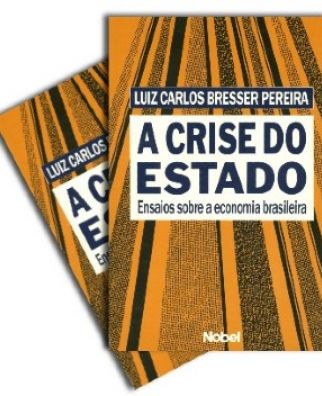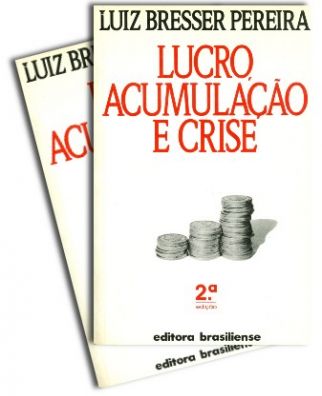2010. The Brazilian economy is undergoing deindustrialization due to a chronic overvaluation of the real. The structural development macroeconomics that I have been developing since the early 2000s explains why. (Cadernos FGV Projetos)
NEW-DEVELOPMENTAL THEORY (NDT)
ND - DUTCH DISEASE AND THE EXCHANGE RATE
2009. Uma doença holandesa moderada e a consequente desindustrialização são evidente. Nega-se o fato porque no momento em que isto for reconhecido não restará alternativa senão mudar a política cambial. Valor Econômico, 25.11.2009
2009. Why some middle income countries catch up while others do not. Behind new developmentalism this book drafts a structuralist development macroeconomics in which the exchange rate plays a strategic role. (Book: Elsevier).Disponível nas livrarias
2008. A country suffering from the Dutch disease has two "equilibrium" exchange rates: the "current equilibrium" that is inconsistent with economic growth, and the"industrial equilibrium" that will be achieved if the country is able to neutralize the disease. (Paper: Brazilian Journal of Political Economy)
2008. A country suffering from the Dutch disease has two "equilibrium" exchange rates: the "current equilibrium" that is inconsistent with economic growth, and the"industrial equilibrium" that will be achieved if the country is able to neutralize the disease. (Paper in edited book) English version published in Brazilian Journal of Political Economy)
2008. Argentina neutralizes its Dutch disease by imposing a tax (retención) on exports. If they were eliminated, the peso would proportionally appreciate and farmers would have no gain. (Article: Valor).
2008. In order to transform the "pre-sal" in wealth, not in a curse, it will be necessary to neutralize the embodied Dutch disease. (Debate: Folha de S.Paulo).
2008. The key problem to be solved is how to neutralize the Dutch disease. A 100% national state enterprise may be a good instrument for that. (Article: Folha de S.Paulo).
2008. With Nelson Marconi. In Brazil the Dutch disease is not as serious as in oil countries, but it is sufficiently serious to cause gradual deindustrialization. Paper in edited book. (Paper in Doença Holandesa e Indústria)
2008. The tax on exports in Argentina to neutralize the Dutch disease is not really paid by farmers because if it was eliminated the exchange rate would fall down and farmers would be in worse situation. (Article: Folha de S.Paulo).
2008. The manufacturing industry is growing while it is prematurely desindustrializing due to moderate but not neutralized Dutch disease. (Article: Folha de S.Paulo).
2007. Response to the Carta do IBRE of the previous month cricizing my proposal of using a variable export tax do neutralize the Dutch disease (Conjuntura Econômica, October)
2007. An encompassing analysis of the Brazilian macroeconomic system. A first presentation of the developmental macroeconomics. Why Brazil failed to grow fast after the Real Plan. (Book: Editora 34) Out of print; availble in this site. English version available: Developing Brazil (2009).
2007. The Dutch disease is appreciating dangerously the real. Tarifs are an incomplete but effective way of neutralizing such major market failure. The Brazilin authorities are correct in rejectind the Doha negotiatins. (Article: Folha de S.Paulo).
2007. The competent neutralization of the Dutch disease requires an export contribution on the goods that profit from abudandant and cheap natural resources. Such contributibution must be marginal, keep high profits of producers, while moves upward the supply curve of the product and limits apreciation of the real. The money of the contribution should be used to create a stabilization fund for primary commodities. (Article: Valor).
2007. Given the Dutch disease, I am not proposing confiscation but a marginal tax on exports that will not hurt but will stabilize commodities' production and profitability. (Two articles by Celso Ming and my letter to him)
2007. Interview to Tatiana Bautzer on the book "Macroeconomia da Estagnação": the Dutch disease is one of the causes of real's overapreciation. (Valor, 18.5)
2007. Short interview on the Dutch Disease in Brazil. (O Estado de S.Paulo).
2007. If we compare the real and effective exchange rate in Brazil before 1990-92 with the present one, it will be clear that Brazil is victim of the Dutch disease. Before that, we were able to neutralize it we are not anymore, and the consequence is disastrous to the Brazilian economy. (Article: Folha de S.Paulo)
2006. The causes of the desindustrialization and quasi-stagnation of the economy are a non-neutralized Dutch disease and the policy of growth with foreign savings. (Article: Folha de S.Paulo)

























